Dongling Xiao
Improving Factuality in Large Language Models via Decoding-Time Hallucinatory and Truthful Comparators
Aug 22, 2024



Abstract:Despite their remarkable capabilities, Large Language Models (LLMs) are prone to generate responses that contradict verifiable facts, i.e., unfaithful hallucination content. Existing efforts generally focus on optimizing model parameters or editing semantic representations, which compromise the internal factual knowledge of target LLMs. In addition, hallucinations typically exhibit multifaceted patterns in downstream tasks, limiting the model's holistic performance across tasks. In this paper, we propose a Comparator-driven Decoding-Time (CDT) framework to alleviate the response hallucination. Firstly, we construct hallucinatory and truthful comparators with multi-task fine-tuning samples. In this case, we present an instruction prototype-guided mixture of experts strategy to enhance the ability of the corresponding comparators to capture different hallucination or truthfulness patterns in distinct task instructions. CDT constrains next-token predictions to factuality-robust distributions by contrasting the logit differences between the target LLMs and these comparators. Systematic experiments on multiple downstream tasks show that our framework can significantly improve the model performance and response factuality.
Detecting and Evaluating Medical Hallucinations in Large Vision Language Models
Jun 14, 2024



Abstract:Large Vision Language Models (LVLMs) are increasingly integral to healthcare applications, including medical visual question answering and imaging report generation. While these models inherit the robust capabilities of foundational Large Language Models (LLMs), they also inherit susceptibility to hallucinations-a significant concern in high-stakes medical contexts where the margin for error is minimal. However, currently, there are no dedicated methods or benchmarks for hallucination detection and evaluation in the medical field. To bridge this gap, we introduce Med-HallMark, the first benchmark specifically designed for hallucination detection and evaluation within the medical multimodal domain. This benchmark provides multi-tasking hallucination support, multifaceted hallucination data, and hierarchical hallucination categorization. Furthermore, we propose the MediHall Score, a new medical evaluative metric designed to assess LVLMs' hallucinations through a hierarchical scoring system that considers the severity and type of hallucination, thereby enabling a granular assessment of potential clinical impacts. We also present MediHallDetector, a novel Medical LVLM engineered for precise hallucination detection, which employs multitask training for hallucination detection. Through extensive experimental evaluations, we establish baselines for popular LVLMs using our benchmark. The findings indicate that MediHall Score provides a more nuanced understanding of hallucination impacts compared to traditional metrics and demonstrate the enhanced performance of MediHallDetector. We hope this work can significantly improve the reliability of LVLMs in medical applications. All resources of this work will be released soon.
PediatricsGPT: Large Language Models as Chinese Medical Assistants for Pediatric Applications
May 29, 2024
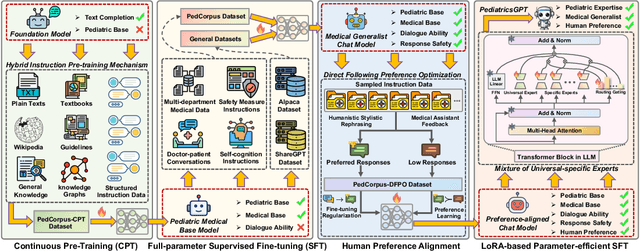
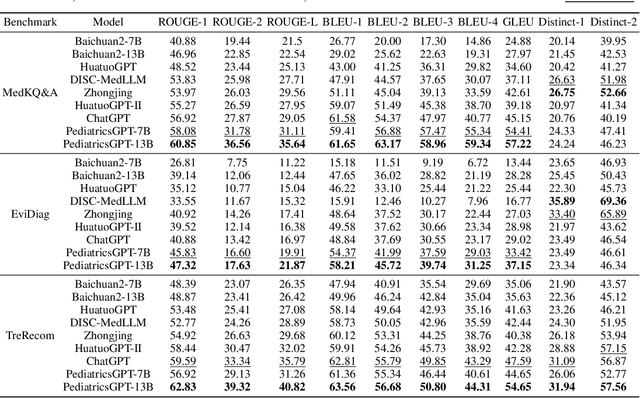

Abstract:Developing intelligent pediatric consultation systems offers promising prospects for improving diagnostic efficiency, especially in China, where healthcare resources are scarce. Despite recent advances in Large Language Models (LLMs) for Chinese medicine, their performance is sub-optimal in pediatric applications due to inadequate instruction data and vulnerable training procedures. To address the above issues, this paper builds PedCorpus, a high-quality dataset of over 300,000 multi-task instructions from pediatric textbooks, guidelines, and knowledge graph resources to fulfil diverse diagnostic demands. Upon well-designed PedCorpus, we propose PediatricsGPT, the first Chinese pediatric LLM assistant built on a systematic and robust training pipeline. In the continuous pre-training phase, we introduce a hybrid instruction pre-training mechanism to mitigate the internal-injected knowledge inconsistency of LLMs for medical domain adaptation. Immediately, the full-parameter Supervised Fine-Tuning (SFT) is utilized to incorporate the general medical knowledge schema into the models. After that, we devise a direct following preference optimization to enhance the generation of pediatrician-like humanistic responses. In the parameter-efficient secondary SFT phase, a mixture of universal-specific experts strategy is presented to resolve the competency conflict between medical generalist and pediatric expertise mastery. Extensive results based on the metrics, GPT-4, and doctor evaluations on distinct doctor downstream tasks show that PediatricsGPT consistently outperforms previous Chinese medical LLMs. Our model and dataset will be open-source for community development.
Towards Multimodal Human Intention Understanding Debiasing via Subject-Deconfounding
Mar 08, 2024



Abstract:Multimodal intention understanding (MIU) is an indispensable component of human expression analysis (e.g., sentiment or humor) from heterogeneous modalities, including visual postures, linguistic contents, and acoustic behaviors. Existing works invariably focus on designing sophisticated structures or fusion strategies to achieve impressive improvements. Unfortunately, they all suffer from the subject variation problem due to data distribution discrepancies among subjects. Concretely, MIU models are easily misled by distinct subjects with different expression customs and characteristics in the training data to learn subject-specific spurious correlations, significantly limiting performance and generalizability across uninitiated subjects.Motivated by this observation, we introduce a recapitulative causal graph to formulate the MIU procedure and analyze the confounding effect of subjects. Then, we propose SuCI, a simple yet effective causal intervention module to disentangle the impact of subjects acting as unobserved confounders and achieve model training via true causal effects. As a plug-and-play component, SuCI can be widely applied to most methods that seek unbiased predictions. Comprehensive experiments on several MIU benchmarks clearly demonstrate the effectiveness of the proposed module.
Towards Multimodal Sentiment Analysis Debiasing via Bias Purification
Mar 08, 2024Abstract:Multimodal Sentiment Analysis (MSA) aims to understand human intentions by integrating emotion-related clues from diverse modalities, such as visual, language, and audio. Unfortunately, the current MSA task invariably suffers from unplanned dataset biases, particularly multimodal utterance-level label bias and word-level context bias. These harmful biases potentially mislead models to focus on statistical shortcuts and spurious correlations, causing severe performance bottlenecks. To alleviate these issues, we present a Multimodal Counterfactual Inference Sentiment (MCIS) analysis framework based on causality rather than conventional likelihood. Concretely, we first formulate a causal graph to discover harmful biases from already-trained vanilla models. In the inference phase, given a factual multimodal input, MCIS imagines two counterfactual scenarios to purify and mitigate these biases. Then, MCIS can make unbiased decisions from biased observations by comparing factual and counterfactual outcomes. We conduct extensive experiments on several standard MSA benchmarks. Qualitative and quantitative results show the effectiveness of the proposed framework.
QURG: Question Rewriting Guided Context-Dependent Text-to-SQL Semantic Parsing
May 16, 2023Abstract:Context-dependent Text-to-SQL aims to translate multi-turn natural language questions into SQL queries. Despite various methods have exploited context-dependence information implicitly for contextual SQL parsing, there are few attempts to explicitly address the dependencies between current question and question context. This paper presents QURG, a novel Question Rewriting Guided approach to help the models achieve adequate contextual understanding. Specifically, we first train a question rewriting model to complete the current question based on question context, and convert them into a rewriting edit matrix. We further design a two-stream matrix encoder to jointly model the rewriting relations between question and context, and the schema linking relations between natural language and structured schema. Experimental results show that QURG significantly improves the performances on two large-scale context-dependent datasets SParC and CoSQL, especially for hard and long-turn questions.
CQR-SQL: Conversational Question Reformulation Enhanced Context-Dependent Text-to-SQL Parsers
May 17, 2022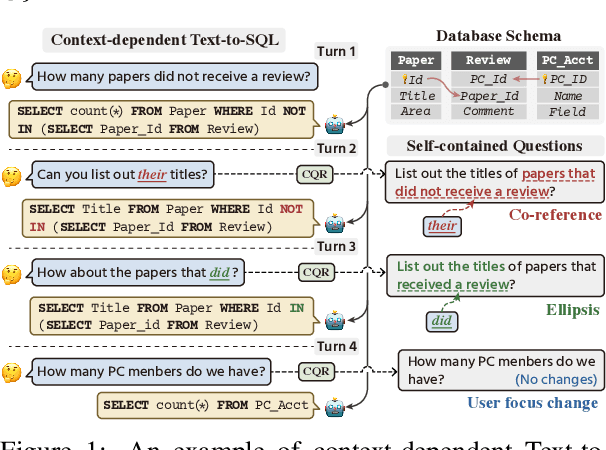


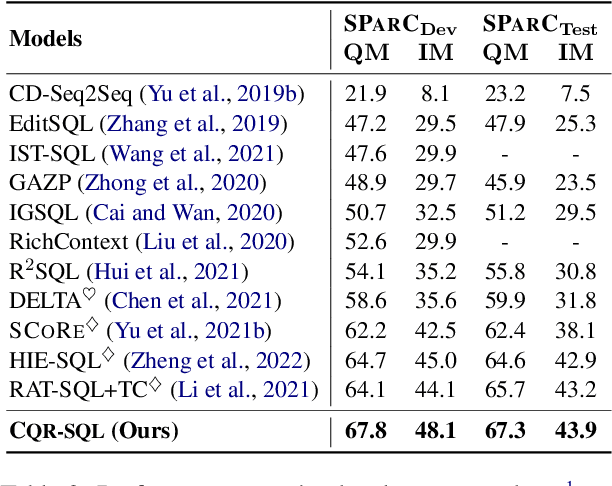
Abstract:Context-dependent text-to-SQL is the task of translating multi-turn questions into database-related SQL queries. Existing methods typically focus on making full use of history context or previously predicted SQL for currently SQL parsing, while neglecting to explicitly comprehend the schema and conversational dependency, such as co-reference, ellipsis and user focus change. In this paper, we propose CQR-SQL, which uses auxiliary Conversational Question Reformulation (CQR) learning to explicitly exploit schema and decouple contextual dependency for SQL parsing. Specifically, we first present a schema enhanced recursive CQR method to produce domain-relevant self-contained questions. Secondly, we train CQR-SQL models to map the semantics of multi-turn questions and auxiliary self-contained questions into the same latent space through schema grounding consistency task and tree-structured SQL parsing consistency task, which enhances the abilities of SQL parsing by adequately contextual understanding. At the time of writing, our CQR-SQL achieves new state-of-the-art results on two context-dependent text-to-SQL benchmarks SParC and CoSQL.
ERNIE-Gram: Pre-Training with Explicitly N-Gram Masked Language Modeling for Natural Language Understanding
Oct 23, 2020
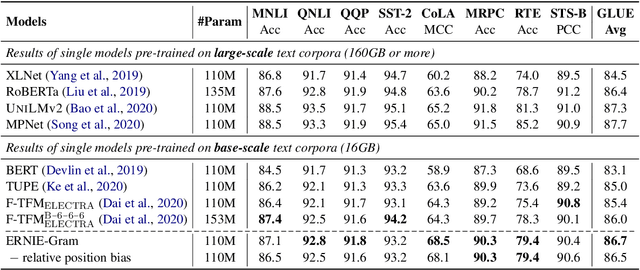
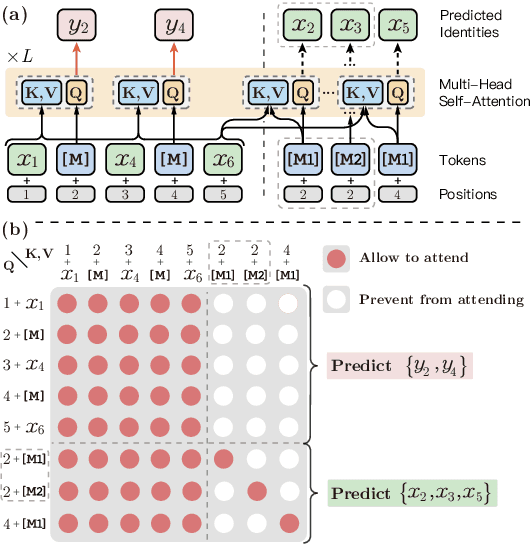
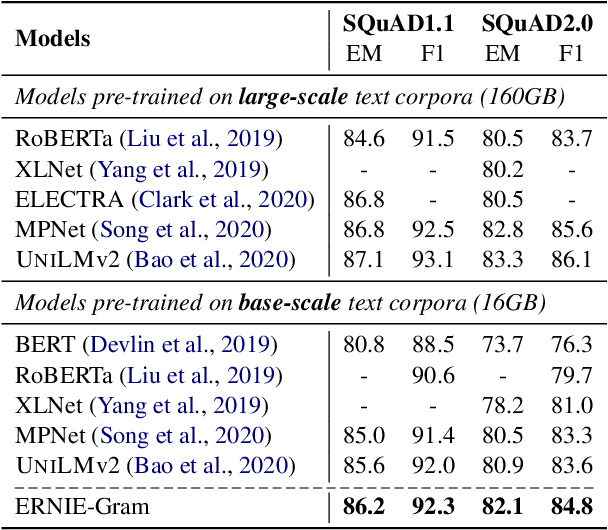
Abstract:Coarse-grained linguistic information, such as name entities or phrases, facilitates adequately representation learning in pre-training. Previous works mainly focus on extending the objective of BERT's Masked Language Modeling (MLM) from masking individual tokens to contiguous sequences of n tokens. We argue that such continuously masking method neglects to model the inner-dependencies and inter-relation of coarse-grained information. As an alternative, we propose ERNIE-Gram, an explicitly n-gram masking method to enhance the integration of coarse-grained information for pre-training. In ERNIE-Gram, n-grams are masked and predicted directly using explicit n-gram identities rather than contiguous sequences of tokens. Furthermore, ERNIE-Gram employs a generator model to sample plausible n-gram identities as optional n-gram masks and predict them in both coarse-grained and fine-grained manners to enable comprehensive n-gram prediction and relation modeling. We pre-train ERNIE-Gram on English and Chinese text corpora and fine-tune on 19 downstream tasks. Experimental results show that ERNIE-Gram outperforms previous pre-training models like XLNet and RoBERTa by a large margin, and achieves comparable results with state-of-the-art methods.
ERNIE-GEN: An Enhanced Multi-Flow Pre-training and Fine-tuning Framework for Natural Language Generation
Feb 04, 2020

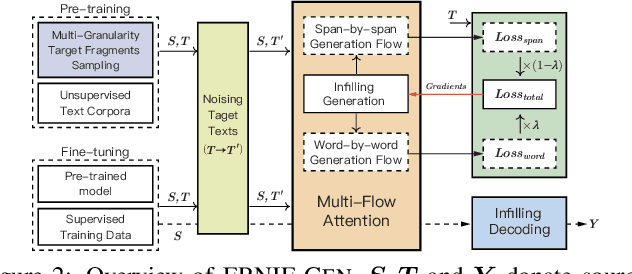

Abstract:Current pre-training works in natural language generation pay little attention to the problem of exposure bias on downstream tasks. To address this issue, we propose an enhanced multi-flow sequence to sequence pre-training and fine-tuning framework named ERNIE-GEN, which bridges the discrepancy between training and inference with an infilling generation mechanism and a noise-aware generation method. To make generation closer to human writing patterns, this framework introduces a span-by-span generation flow that trains the model to predict semantically-complete spans consecutively rather than predicting word by word. Unlike existing pre-training methods, ERNIE-GEN incorporates multi-granularity target sampling to construct pre-training data, which enhances the correlation between encoder and decoder. Experimental results demonstrate that ERNIE-GEN achieves state-of-the-art results with a much smaller amount of pre-training data and parameters on a range of language generation tasks, including abstractive summarization (Gigaword and CNN/DailyMail), question generation (SQuAD), dialogue generation (Persona-Chat) and generative question answering (CoQA).
 Add to Chrome
Add to Chrome Add to Firefox
Add to Firefox Add to Edge
Add to Edge